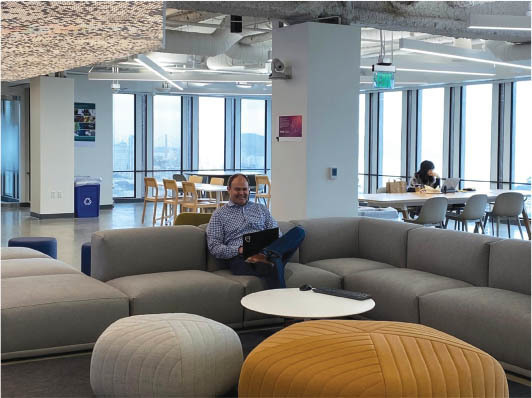BY SCOTT O. JONES, PE
In case you haven’t heard, the answer to most things in life is this: Find a balance. Whether you’re tackling a new health goal, striving for work-life equilibrium or even negotiating with a client—the sweet spot lies somewhere in the middle. People seek balance, and guess what? They look for it in their physical surroundings, too.
Today’s tech-filled era has introduced unbelievable possibilities to advance and enrich workplace experiences. But technology can’t do all the work. When distracted by all the shiny gadgets and gizmos, we can lose sight of the end goal: to cultivate a space where people want to be, not have to be.
As long as offices are occupied by people (robot invasion theories aside), they will need to be designed for people. People who, unlike robots, are called to do more than function—they want to thrive. They want to create, optimize and engage.
When we talk about human-centered design (see "Designing for the Human Experience"), we are talking about work environments that cater to these complex ambitions through a harmonious integration of resources. This brings back that idea of balance: It is an intentional combination of private and collaborative spaces, hardware and soft finishes, uniformity and customization that elevates an office from four walls and some desks to a dynamic innovation hub.
My company, Jacobs, recently completed this balancing act in the overhaul of our San Francisco office (pictured below). As an employee, I have experienced the positive effects of these upgrades in my own productivity, and as a boss, I’ve seen my team return to the office with a renewed excitement for their work each day. Because of upgrades like streamlined conference call coordination or a sound system that emits white noise, the Jacobs team is more able to channel that human-centric instinct to create, optimize and engage—a boost that directly transfers value to the company and its clients.
And again, not every solution needs to be tech-enabled. One of my favorite features of the new office is the glass meeting rooms, which are designed to bring natural energy from the sun—and to offer a view of iconic San Francisco landmarks like the Golden Gate Bridge and Alcatraz. Not to mention, the office includes a variety of reservable and non-reservable meeting spaces—another example of balance at play. Of course, the project wouldn’t be complete without offering a balanced variety of work environments, like dynamic desk pods that transform into privately enclosed work areas or an open, lounge-like space reminiscent of a coffee shop.
These changes have provided our employees with the opportunity to do their best work by allowing them to do so in a way that feels natural to them. This is the kind of environment that the property professionals who make up BOMA strive to help tenant companies provide.
The start of a new year is a popular time for people to work toward a better version of themselves. I challenge you all to revisit how your building helps your occupants activate their full potential. Ask yourself: Does every bell and whistle provide value? Does it provide a balanced assortment of resources to meet every kind of person’s needs? And finally, is your building a place where people can merely function or is it a place where they can thrive?

This article was originally published in the January/February 2020 issue of BOMA Magazine.